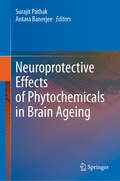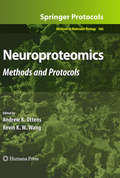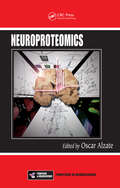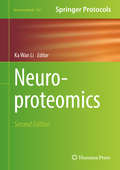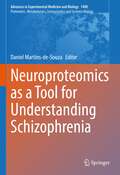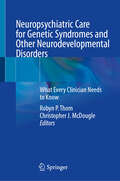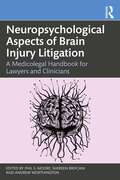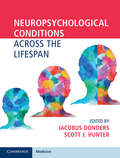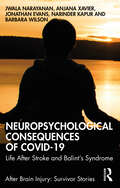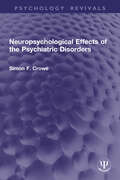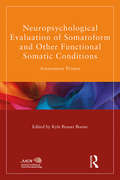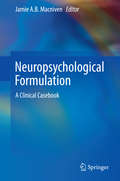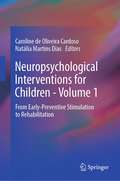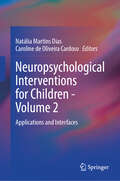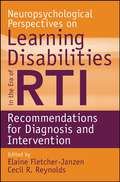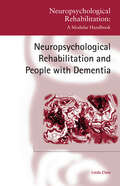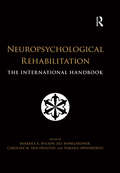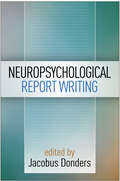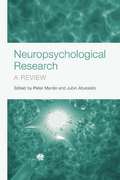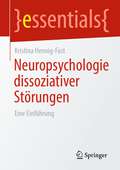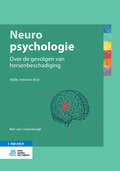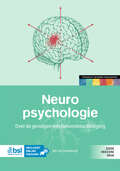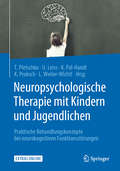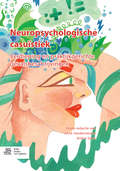- Table View
- List View
Neuroprotective Effects of Phytochemicals in Brain Ageing
by Surajit Pathak Antara BanerjeeThis book discusses the mechanism and therapeutic strategies of phytochemicals against brain ageing. It discusses the underlying anti-oxidative and anti-inflammatory mechanisms of the phytochemicals and the implications of these compounds in the prevention and treatment of geriatric diseases. It discusses the potential role of the highly complex interactive network between the gut and the brain in neurodegenerative diseases such as Parkinson’s disease (PD), and Alzheimer’s disease. The chapters provide insight into the mechanisms involved in brain ageing and the mechanism of actions of the phytochemicals that might be crucial in developing effective new therapies against brain ageing. The chapter also presents the mechanisms of action of phytoconstituents, bioavailabilities, and their effects on neuroinflammation. The chapters also examine the phytochemicals protection of neurons via targeting oxidative stress, mitochondrial dysfunction, neurotrophic factor deficit, apoptosis, and abnormal protein accumulation. This book aims to provide comprehensive and cutting-edge information on the potential neuroprotective role of phytochemicals on the brain and neurological disorders to researchers, neuroscientists, clinical nutritionists, and physicians.
Neuroproteomics
by Andrew K. Ottens Kevin K.W. WangWith the development of polypeptide ionization processes for mass spectrometry and the rapid processing of large-scale datasets with bioinformatics, researchers now have the tools necessary to propel neuroproteomics research to new levels. In Neuroproteomics: Methods and Protocols, experts in the neurological and analytical sciences present experimental details for applying proteomics to the study of the central nervous system (CNS) and its dysfunction through trauma and disease. Divided into four convenient sections, this collection covers CNS animal models used for neuroproteomics research, methods for separating and analyzing discrete subcomponents of the neuroproteome, large-scale approaches for CNS proteome characterization and quantification, as well as methods that evaluate biofluids and translate neuroproteomic results into clinical platforms. As a volume in the highly successful Methods in Molecular BiologyTM series, chapters include brief introductions to their respective topics, lists of the necessary materials and reagents, step-by-step, readily reproducible laboratory protocols, and notes on troubleshooting and avoiding known pitfalls. Authoritative and cutting-edge, Neuroproteomics: Methods and Protocols includes the clear "how-to" information needed to critically assess what can be accomplished in the field and how to best perform and evaluate neuroproteomic experiments in one's own research.
Neuroproteomics
by Oscar AlzateIn this, the post-genomic age, our knowledge of biological systems continues to expand and progress. As the research becomes more focused, so too does the data. Genomic research progresses to proteomics and brings us to a deeper understanding of the behavior and function of protein clusters. And now proteomics gives way to neuroproteomics as we beg
Neuroproteomics (Neuromethods #146)
by Ka Wan LiThis second edition volume expands on the previous edition with updates on the latest techniques used in the field of proteomics. Tissue and cellular proteins are now being analyzed at near proteome-wide levels and mass spectrometers are achieving higher sensitivity and speed, resolution, and accuracy. The chapters in this book cover various new methods used in proteomic workflows such as laser microdissection for spatial proteomics of post-mortem brain tissue, sample preparation in single vessel with FASP and SP3 protocols, the crosslinking mass spectrometry, TMT-MS3 based proteomic with synchronous precursor selection, mass spectrometric data dependent acquisition (DDA) and data independent acquisition (DIA, SWATH) methods, 2D-DIGE, and MALDI Imaging Mass Spectrometry. In Neuromethods series style, chapters include the kind of detail and key advice from the specialists needed to get successful results in your laboratory.Cutting-edge and comprehensive, Neuroproteomics, Second Edition is a valuable guide that help researchers obtain the finest results from current proteomics platforms.
Neuroproteomics as a Tool for Understanding Schizophrenia (Advances in Experimental Medicine and Biology #1400)
by Daniel Martins-de-SouzaOver the past decade, neuroproteomics has shed light on the molecular features of schizophrenia by depicting biological processes involved with its establishment, maintenance and treatment. These studies have also pointed to potential biomarkers applicable to diagnosis and medication monitoring. Edited by a leader in the field of neuroproteomics with contributions from subject experts, this new volume will address recent findings and compile evidence from difference perspectives—such as human samples, animal models, pluripotent stem cell-derived in vitro pre-clinical models—and provide findings to inform the development of innovative future treatment strategies.This volume will be useful for a broad audience of researchers and professionals, including biologists, neurologists, psychiatrists, analytical chemists, and pharmacists, among others.
Neuropsychiatric Care for Genetic Syndromes and Other Neurodevelopmental Disorders: What Every Clinician Needs to Know
by Christopher J. McDougle Robyn P. ThomChildren and adults with developmental disabilities are at increased risk for experiencing behavioral problems and psychiatric comorbidities compared to the general population and several neurodevelopmental disorders are associated with certain neuropsychiatric conditions. Because of language and cognitive differences, the clinical presentation of these conditions can differ from what is seen in the general population. Furthermore, research on treatment approaches for psychiatric comorbidities in these populations is extremely limited and evidence-based treatment guidelines do not exist. This book is a collection of neurodevelopmental disorders that are frequently associated with relatively distinct and common psychiatric co-morbidities across the lifespan. Each chapter addresses a different neurodevelopmental disorder by providing an overview, symptoms of common psychiatric co-morbidities, assessment strategies, psychosocial and biological treatments, and common medical co-morbidities the clinician needs to have basic knowledge of with regards to choosing safe and appropriate pharmacotherapy. Given how relatively rare many of these syndromes are, the practicing clinician generally does not encounter a sufficient number of cases during training or clinical practice to develop comfort and expertise in each of them. Furthermore, there are no easy to access evidence-based treatment guidelines. This succinct and practical resource fills a needed gap for an overview of the most common neurodevelopmental disorders in a single resource with a clinical expert’s approach to diagnosis and management.
Neuropsychological Aspects of Brain Injury Litigation: A Medicolegal Handbook for Lawyers and Clinicians
by Phil S. MooreThis accessible handbook focuses on the importance of neuropsychological evidence and the role of the neuropsychologist as expert witness in brain injury litigation. This thorough, evidence-based resource fosters discussion between the legal profession and expert neuropsychological witnesses. The chapters reflect collaborations between leading personal injury lawyers and neuropsychologists in the UK. Key issues in brain injury litigation are addressed that are essential to an understanding of the role of the neuropsychologist as expert witness and of neuropsychological evidence for the courts. These include neuropsychological testing, assessment of quantum, vocational rehabilitation, mental capacity, forensic outcomes, the frontal paradox, mild traumatic brain injury and more. Combining the scientific and legal background with practical tips and case examples, this book is valuable reading for legal professionals, particularly those working in personal injury and clinical negligence, as well as trainees, students and clinicians in the field of neuropsychology, neurorehabilitation and clinical psychology.
Neuropsychological Conditions Across the Lifespan
by Jacobus Donders Scott J. HunterThis unique analysis of neuropsychological conditions provides readers with a review of both pediatric and adult presentations in one convenient place. Covering the most common disorders encountered in clinical practice, including those specific to the extremes of the age spectrum, this book provides dedicated chapters on: • Preterm and low weight birth • Spina bifida myelomeningocele • Autism spectrum disorder • Intellectual disability • Fetal alcohol spectrum disorders • Attention-deficit/hyperactivity disorder • Learning disability • Traumatic brain injury • Cancer • Epilepsy • Human immunodeficiency virus • Multiple sclerosis • Stroke • Dementia Each chapter provides evidence-based guidelines that can be readily applied to daily practice.
Neuropsychological Consequences of COVID-19: Life After Stroke and Balint's Syndrome (ISSN)
by Barbara Wilson Jonathan Evans Narinder Kapur Jwala Narayanan Anjana XavierNeuropsychological Consequences of COVID-19 focuses on Anjana’s journey as a COVID survivor following a brain injury that left her with a very rare neuropsychological syndrome called Balint’s syndrome, a disorder associated with difficulties in visual and spatial coordination. It is also the first book of its kind to provide a first-hand account from India on surviving brain injury, from diagnosis, recovery and rehabilitation, providing the therapeutic milieu in the Indian context and exploring cultural influences on rehabilitation.Written jointly by Anjana, her neuropsychologist and the international experts in the field of neuropsychology who were also involved in her diagnosis and care, the book highlights how COVID-19, a virus primarily affecting the respiratory system, can also result in a disabling brain injury. It describes Anjana’s recovery and the rehabilitation she received and provides a deeper understanding of this experience of a very rare condition through the views of Anjana herself. In addition, Anjana’s rehabilitation journey stumbles upon many important themes of rehabilitation including cultural sensitivity, personal identity, resilience, role of family and rehabilitation in a low to middle income country.This book is valuable reading for clinical and neuropsychologists, neurologists, other rehabilitation therapists including physiotherapists, occupational therapists, nurses and social work professionals, particularly those interested in cross cultural rehabilitation. It will also be of interest to students in these fields.
Neuropsychological Effects of the Psychiatric Disorders (Psychology Revivals)
by Simon F. CroweOriginally published in 1998, Neuropsychological Effects of the Psychiatric Disorders provided a comprehensive review of the background and literature concerning effects of the psychiatric disorders on cognitive functions at the time. It follows the classification of disease proposed by the Diagnostic and Statistical Manual of Mental Disorders (DSM-IV) and each condition is described in terms of its history, details regarding physical investigations of brain functioning in the disorder, and an extensive review and formulation of the implications of that disorder to cognitive functioning. A selective review of cognitive effects of treatments of the psychiatric disorders both pharmacological and physical is also included.Each chapter features a fully worked case of a disorder in association with the background and presentation of the patient, as well as a full listing of the patient’s performance on specific neuropsychological tests. Techniques for differentiating dementia from depressive illness, as well as clinical guidelines and decision rules in areas of the factitious and dissociative disorders are described. The text is written with an eye to the history of these conditions and contains anecdotal material regarding interesting findings and red herrings.
Neuropsychological Evaluation of Somatoform and Other Functional Somatic Conditions: Assessment Primer (American Academy of Clinical Neuropsychology/Routledge Continuing Education Series)
by Kyle Brauer BooneNeuropsychologists are provided with little formal education and training regarding the identification and measurement of somatoform symptoms, yet these conditions are highly prevalent, with estimates indicating that 20% of general medical patients and 30% of neurologic clinic patients present with symptoms lacking medical explanation. This book provides neuropsychologists with comprehensive information and specific practice recommendations for the assessment of patients with somatoform conditions. The first four chapters discuss the genesis of somatoform and other functional somatic symptom disorders, and the next seven chapters address somatoform conditions in the context of nonepileptic seizures, multiple chemical sensitivity and other claimed toxic exposures, pseudotremor and other nonphysiologic movement disorders, postconcussion syndrome, chronic pain/fibromyalgia/complex regional pain syndrome, attention deficit disorder, and auto-immune disease. Chapters are also included that address the use of the MMPI-2-RF in differentiating somatoform disorder and malingering, medically unexplained symptoms in non-English-speaking individuals; workplace factors in somatization; and testimony involving somatoform conditions. The book is targeted for practicing neuropsychologists, clinical psychologists including those specializing in behavioral medicine, and students in training.
Neuropsychological Formulation
by Jamie A.B. MacnivenThis forward-looking reference defines and illustrates the process and themes of formulation in neuropsychology and places it in the vanguard of current practice. The book explains the types of information that go into formulations, how they are gathered, and how they are synthesized into a clinically useful presentation describing psychological conditions resulting from neurological illness or injury. Cases highlight the relevance and flexibility of narrative- and diagram-based formulation methods in approaching a diverse range of issues and conditions, from decisional capacity to cultural considerations, Huntington's disease to deep dyslexia. Throughout this volume, formulation is shown as integral to treatment and rehabilitation planning alongside clinical assessment, cognitive testing, and diagnosis. Included among the topics: The interface of neuroimaging with neuropsychological findings in traumatic brain injury. Neuropsychological aspects of temporal-lobe epilepsy: seeking evidence-based practice. An integrative approach to differential diagnosis of subarachnoid hemorrhage and Korsakoff's dementia. Educational disengagement following mild TBI in childhood. Themes in the formulation of repeat assessments. Cognitive neuropsychological formulation. Formulation is essential in good neuropsychological assessment as it provides the foundation for appropriate intervention by bringi ng together the results of different evaluations into a coherent whole. . . . Macniven's compelling and constructive book has assembled internationally known experts from diverse backgrounds to provide illumination of their own views and approaches to formulation, which makes the book a pleasure to read and should establish it as essential reading on clinical psychology and neuropsychology training courses. - Professor Barbara A. Wilson OBE, Ph. D. ,D. Sc. Neuropsychologists, clinical psychologists, and rehabilitation specialists will find Neuropsychological Formulation of critical importance not only to the literature of the field, but also to the developing role of clinical neuropsychology within healthcare systems.
Neuropsychological Interventions for Children - Volume 1: From Early-Preventive Stimulation to Rehabilitation
by Caroline de Oliveira Cardoso Natália Martins DiasThis book is the first of two volumes that aim to serve as a comprehensive guide for professionals working with neuropsychological interventions especially designed for children. This first volume presents the theoretical foundations, tips and guidelines for neuropsychologists to develop different interventions, such as stimulation and early intervention with a focus on promoting neuropsychological health; habilitation, appropriate for work with neurodevelopment disorders; and rehabilitation, in cases of structural alterations. In this sense, it reflects the editors' concern to provide material with practical tips, but theoretically grounded, and truly useful to professionals in clinical and also school contexts. This first volume is divided into two parts. The first addresses the theoretical and practical foundations of child neuropsychological assessment and intervention. Neuropsychological assessment is discussed, with a focus on its role in guiding intervention. Also, different types of interventions are presented, and a taxonomy is offered, according to its differential objectives of promotion or remediation and the target population (typical development, functional or structural alterations of the Nervous System), leading to the suggestion of three types of interventions in neuropsychology in both clinical and school contexts: 1) Early preventive Intervention; 2) Habilitation and 3) Rehabilitation. Cognitive stimulation in different contexts, such as school, family and clinical, is also discussed, exploring how teachers and parents can also collaborate in intervention processes, expanding the possibilities for action beyond the clinical context. A section concludes by addressing the importance of the feedback and the neuropsychological assessment report.The second part focuses specifically on stimulation and rehabilitation, offering chapters that target specific skills such as attention, memory, executive functions and academic skills, among others. The chapters summarize evidence, bring tips and illustrate existing materials and programs, in a continuous articulation between theory-evidence-practice. Originally published in Portuguese and now available in English, Neuropsychological Interventions for Children – Volumes 1 and 2 will be of interest to professionals working with neuropsychology in clinical and school contexts. It will also be useful in neuropsychology teaching contexts (specialization courses in neuropsychology and related areas) and for students and professionals in interface areas, such as Psychology, Education, Speech Therapy, Occupational Therapy among others. The translation of the original Portuguese version of this book into English was done with the help of artificial intelligence. A subsequent human revision was done primarily in terms of content.
Neuropsychological Interventions for Children - Volume 2: Applications and Interfaces
by Caroline de Oliveira Cardoso Natália Martins DiasThis book is the second of two volumes that aim to serve as a comprehensive guide for professionals working with neuropsychological interventions especially designed for children. This second volume complements the theoretical and practical foundations presented in the first volume by presenting applications to different clinical conditions and by exploring interfaces of neuropsychology with other areas of research and practice. Chapters in this second volume are divided into two parts. The first part presents a series of case studies, illustrating the practice and experience of neuropsychological rehabilitation and habilitation in different clinical conditions. The second part brings together chapters that discuss the interfaces of neuropsychology with different areas, which can use its knowledge and interventions (such as school neuropsychology) or which can be used as strategies within neuropsychological intervention or even compose inter and transdisciplinary partnerships in the work of promotion, stimulation, or cognitive remediation, such as the use and role of music, games and play, mindfulness, and transcranial direct current stimulation. So, chapters in this second part highlight the interfaces with other approaches, knowledges or disciplines. Originally published in Portuguese and now available in English, Neuropsychological Interventions for Children – Volumes 1 and 2 will be of interest to professionals working with neuropsychology in clinical and school contexts. It will also be useful in neuropsychology teaching contexts (specialization courses in neuropsychology and related areas) and for students and professionals in interface areas, such as Psychology, Education, Speech Therapy, Occupational Therapy among others. The translation of the original Portuguese version of this book into English was done with the help of artificial intelligence. A subsequent human revision was done primarily in terms of content.
Neuropsychological Perspectives on Learning Disabilities in the Era of RTI
by Elaine Reynolds Fletcher-Janzen Cecil R.An insightful look at the role of neuroscience and neuropsychology as it relates to Response to Intervention (RTI) in learning disability diagnosis, treatment, and policy reform Neuropsychological Perspectives on Learning Disabilities in the Era of RTI is a revolutionary new volume presenting the latest research--in question-and-answer format--from leading scholars about the contributions of neuroscience and neuropsychology as it relates to Response to Intervention (RTI) in learning disability identification, diagnosis, and recommended interventions. This collective work includes contributions from more than thirty neuroscientists, neuropsychologists, clinical psychologists, and school psychologists with training in brain-behavior relationships, who explore the answers to questions including: How do you reconcile RTI as a means of diagnosis of learning disability with knowledge from the clinical neurosciences?? What do you think neuroscience has to offer laws and policies associated with learning disability determination? What do you think neuroscience has to offer the assessment and identification of learning disabilities? What role does neurocognitive science play in designing interventions in the context of RTI? What role does neuropsychology have to play in the diagnosis of learning disability? Featuring contributions from leaders in the field of neuropsychology and school psychology, and with a Foreword from Sally Shaywitz, Neuropsychological Perspectives on Learning Disabilities in the Era of RTI illuminates the contributions of neuro-science and neuropsychology to learning disability identification and current educational reform.
Neuropsychological Rehabilitation
by Barbara A. Wilson Fergus Gracey Jonathan J. Evans Andrew BatemanAfter an introduction to the current theories and research findings related to brain injury rehabilitation, this text presents 20 case studies of adults who sustained severe brain damage caused by traumatic head injuries, encephalitis, stroke, hypoxia and other conditions. Problems that follow such injuries are analyzed in detail; these include loss of self-care skills, memory impairment, and language, reading, visuoperceptual and behavioral difficulties. The chapters describe the lifestyle of each individual before the onset of brain damage and the subsequent symptoms, neuropsychological assessment, rehabilitation, and long-term outcome of their condition. Most chapters include a report by the patient and/or family member, thus enhancing the reader's understanding of the predicaments faced by brain-injured individuals as they learn to cope with traumatic changes in lifestyle. Although improvement for those with severe brain injuries is slow and limited, the patients described in the book made some progress after their admission to rehabilitation services. The exhaustive analysis of each case and a step-by-step description of management will serve as an inspiring and informative guide for students, professionals and other caregivers.
Neuropsychological Rehabilitation and People with Dementia (Neuropsychological Rehabilitation: A Modular Handbook)
by Linda ClareRehabilitation provides a core concept around which to organise support, intervention and care for people with impairments in memory and other cognitive functions. This book introduces a conceptual framework and rationale for the application of a neuropsychological rehabilitation approach for people with dementia, helping them to manage, bypass or overcome these problems and experience optimum well-being. Methods and techniques of cognitive rehabilitation are described and the process of goal-setting is discussed in detail, showing how effective strategies may be linked to form an individualised, goal-oriented approach to intervention. The application of a rehabilitation approach in real-life contexts is explored, demonstrating the role and value of neuropsychological rehabilitation within a holistic, psychotherapeutic framework of care and support. This overview of the neuropsychological rehabilitation approach to dementia care will be of great interest to psychologists as well as to those studying or practising in the area.
Neuropsychological Rehabilitation: The International Handbook (Studies On Neuropsychology, Neurology And Cognition Ser.)
by Barbara A. Wilson Jill Winegardner Caroline M. van Heugten Tamara OwnsworthThis outstanding new handbook offers unique coverage of all aspects of neuropsychological rehabilitation. Compiled by the world’s leading clinician-researchers, and written by an exceptional team of international contributors, the book is vast in scope, including chapters on the many and varied components of neuropsychological rehabilitation across the life span within one volume. Divided into sections, the first part looks at general issues in neuropsychological rehabilitation including theories and models, assessment and goal setting. The book goes on to examine the different populations referred for neuropsychological rehabilitation and then focuses on the rehabilitation of first cognitive and then psychosocial disorders. New and emerging approaches such as brain training and social robotics are also considered, alongside an extensive section on rehabilitation around the world, particularly in under-resourced settings. The final section offers some general conclusions and an evaluation of the key issues in this important field. This is a landmark publication for neuropsychological rehabilitation. It is the standalone reference text for the field as well as essential reading for all researchers, students and practitioners in clinical neuropsychology, clinical psychology, occupational therapy, and speech and language therapy. It will also be of great value to those in related professions such as neurologists, rehabilitation physicians, rehabilitation psychologists and medics.
Neuropsychological Report Writing (Evidence-Based Practice in Neuropsychology)
by Jacobus DondersAll neuropsychologists need to know how to produce evidence-based reports. This book brings together experts to provide an in-depth guide to high-quality report writing in a range of contexts, including evaluations of older adults, psychiatric patients, those with complex medical conditions, schoolchildren, and others. It reviews the fundamental elements of a clinical neuropsychological report and shows how to tailor findings, conclusions, and recommendations to particular audiences, such as referring physicians, school professionals, and legal decision makers. Of special utility, every chapter features excerpts of sample reports, including examples of strong and poor documentation of the same material.
Neuropsychological Research: A Review
by Jubin AbutalebiIn a broad sense, neuropsychology stands for the branch of brain sciences that aims to understand how the structure and function of the brain relate to specific cognitive and psychological processes. The idea of developing a research field somewhere between neurology and cognitive psychology emerged in the 1960s as a result of studies conducted by both disciplines which, although using different methodologies and tools, were analysing the same issues. Neuropsychology particularly puts emphasis on the clinical and experimental study of the cognitive effects of brain injury or neurological diseases, taking models of normal cognitive functioning into account. Neuropsychological Research: A Review provides a meticulous overview of what has been achieved in the field of cognitive neuropsychology from its early beginnings in the 1960s and 1970s to the present day. Authors include some of the pioneers involved in the genesis of neuropsychology as an independent and distinct field of neuroscience. The comprehensive coverage includes language disorders, skilled movement disorders, recognition disorders, attentional and executive disorders, visuo-perceptual disorders, memory disorders, and neurodegenerative diseases. This fascinating text forms an enjoyable tribute to the rich heritage of neuropsychology, and will be essential reading for researchers and students of neuropsychology, clinical psychology, cognitive psychology, and behavioural neuroscience.
Neuropsychologie dissoziativer Störungen: Eine Einführung (essentials)
by Kristina Hennig-FastIm Bereich der dissoziativen Störungen führt die WHO mit der ICD-11 markante Anpassungen der Klassifikation ein, die unter anderem die jüngeren Forschungsergebnisse der letzten Jahre berücksichtigen. Vor allem im Bereich der Neuropsychologie und Neurowissenschaften zeigt eine Vielzahl von Publikationen, dass kognitive Störungen und deren zugrundliegende neuronalen Veränderungen eine wesentliche Rolle beim Entstehen und beim Aufrechterhalb der Symtpome spielen.Auf der Basis der neuen Erkenntnisse und der Neuerungen werden Behandler:innen auf der Basis der epidemiologischen, äthiologischen und modelltheoretischen Grundlagen mit der Rolle der neurokognitiven Veränderungen und den sich daraus entwickelnden Modellen vertraut gemacht. Die Klassifikation, Diagnostik und Behandlung der Störungen wird in diesem Rahmen beleuchtet. Anhand von Fallbeispielen und Exkursen werden die dissoziativen Störungen praktisch verständlich.
Neuropsychologie: Over de gevolgen van hersenbeschadiging
by Ben Van CranenburghDit boek helpt professionals (in opleiding) om hersenaandoeningen beter te begrijpen. Het bespreekt systematisch welke stoornissen en problemen kunnen ontstaan door hersenbeschadiging, ontwikkelingsstoornissen en degeneratieve aandoeningen. De problemen die de patiënt in zijn dagelijks leven ervaart, zijn daarbij steeds de leidraad. Het boek is met name bedoeld voor therapeuten, artsen, psychologen, verpleegkundigen en studenten. Neuropsychologie, Over de gevolgen van hersenaandoeningen maakt deel uit van de een zesdelige serie ‘Toegepaste neurowetenschappen’. Het boek is gebaseerd op jarenlang onderzoek en talrijke patiëntencasussen. Het boek gaat in op wetenschappelijke ontwikkelingen in de klinische neuropsychologie én beschrijft vragen en situaties uit de praktijk. De eerste hoofdstukken bespreken de uiteenlopende oorzaken en gevolgen van hersenaandoeningen. Vervolgens wordt elke stoornis, zoals afasie en apraxie, uitgewerkt. Ook krijgt u handvatten om in de praktijk een neuropsychologisch onderzoek te doen en krijgt u oefeningen aan de hand van casuïstiek. De volgende hoofdstukken gaan in op neuropsychologische aspecten van ontwikkelingsstoornissen, veroudering en degeneratieve ziekten. Ten slotte ziet u zeven praktijkdiagrammen met uitgewerkte voorbeelden die u direct in de klinische praktijk kan gebruiken. Bij het boek hoort ook een online omgeving met vragen en antwoorden, samenvattingen en verwijzingen naar casuïstiek en video’s.Neurowetenschapper Ben van Cranenburgh studeerde geneeskunde in Amsterdam en was als wetenschappelijk medewerker verbonden aan onder meer het Nederlands Centraal Instituut voor Hersenonderzoek en het Revalidatie Centrum Amsterdam. In 1987 richtte hij het Instituut voor toegepaste neurowetenschappen (ITON) op, waarvan hij tot op heden directeur is. De stichting ITON biedt nascholingscursussen aan op het gebied van de toegepaste Neurowetenschappen.
Neuropsychologie: Over de gevolgen van hersenbeschadiging
by Ben van CranenburghDit boek biedt inzicht in hersenaandoeningen en de gevolgen ervan voor cognitie, mentale processen en gedrag. Het richt zich op neuropsychologische functiestoornissen door hersenbeschadiging, ontwikkelingsstoornissen en neurodegeneratieve aandoeningen. De nadruk ligt op de gevolgen die patiënten in hun dagelijks leven ervaren. Het boek is bedoeld voor studenten, therapeuten, artsen, psychologen en verpleegkundigen. De eerste hoofdstukken geven een overzicht over de uiteenlopende oorzaken en gevolgen van hersenaandoeningen. Daarna volgt een gedetailleerde uitleg over stoornissen als afasie, apraxie, agnosie, amnesie en neglect, met casuïstiek-oefeningen. In aparte hoofdstukken worden neuropsychologische aspecten van ontwikkelingsstoornissen en neurodegeneratieve ziekten behandeld. Bij dit boek hoort een online platform met extra bijlagen, vragen, samenvattingen, casuïstiek en video’s, plus zeven praktijkdiagrammen voor direct gebruik in de klinische praktijk. Het boek is onderdeel van de zesdelige serie ‘Toegepaste neurowetenschappen’ en is gebaseerd op jarenlange studie en ervaring van de auteur.
Neuropsychologische Therapie mit Kindern und Jugendlichen: Praktische Behandlungskonzepte bei neurokognitiven Funktionsstörungen
by Thomas Pletschko Ulrike Leiss Katharina Pal-Handl Karoline Proksch Liesa J. Weiler-WichtlDas Buch stellt neuropsychologische Interventionen aus der Kinder-und Entwicklungsneuropsychologie vor, die maßgeschneidert auf Kinder mit neurokognitiven Funktionsstörungen angewendet werden können – im klinischen wie im ambulanten Kontext. Sie werden mit ihren Einsatzgebieten anschaulich und konkret vorgestellt anhand zahlreicher Fallbeispiele. Dem Leser wird ein konkretes evidenzbasiertes Behandlungskonzept spezifisch für Kinder und Jugendliche präsentiert, in dem verschiedene Methoden zur Anwendung kommen können.
Neuropsychologische casuïstiek: Verdieping en praktijkgerichte gevalsbeschrijvingen
by J.A.M. Vandermeulen M.M.A. DerixDit boek wil een breed inzicht geven in verschillende gebieden van de klinische neuropsychologie bij volwassenen. Het beoogt relevant te zijn voor (klinisch) neuropsychologen, klinisch psychologen, GZ-psychologen, eerstelijnspsychologen en basispsychologen. Het probeert een intensief blikveld te creëren in het onderzoeksterrein waarbinnen de neuropsychologie meandert. er wordt hiervoor in het boek gebruik gemaakt van casuïstiekbeschrijvingen. Het is in de dagelijkse praktijk juist de casuïstiek die steeds weer opnieuw de aandacht opeist om de 'gewone' en bijzondere neuropsychologische problemen, die zich in het dagelijkse leven kunnen voordoen te verhelderen en oplossingen hiervoor bedenken. KERNDOEL Wij willen een boek aanbieden waarbij in de verschillende hoofdstukken uitgegaan wordt van casuïstiek gericht op volwassenen. Het boek moet als een praktisch instrument gebruikt kunnen worden, dit in tegenstelling tot de vele boeken die als een naslagwerk dienen en uiteindelijk meestal langdurig in de kast staat.
